CT scans reveal 3000 year old mummy of Egyptian princess
16 February 2009
Stunning 3D images have revealed details of a mummy that has been sealed in a coffin for more than 3,000 years thanks to a cutting-edge medical scanner developed by Philips.
The elaborately decorated coffin of the Egyptian woman, Meresamun (see photo below), who was believed to be a priestess at a temple in Thebes in 800 BC, has remained intact and completely closed, as curators at the University of Chicago’s Oriental Museum, where she has been for over 80 years, have been reluctant to examine her further and risk destroying the beautiful decorations.
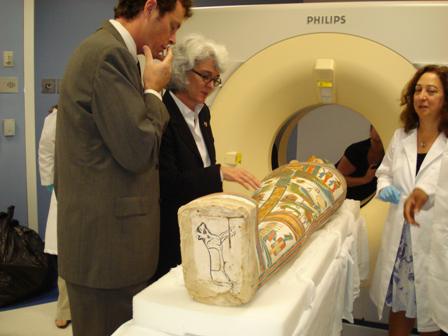
|
Now, thanks to the latest in computed tomography (CT) scanning technology, which is normally used to help diagnose and treat living patients, researchers have been able for the first time to show the world remarkable 3D images of woman who lies preserved inside the beautifully painted casket. Scans had been performed using a 64 slice CT scanner. The scans were then repeated using the Philips 256-slice Brilliance iCT scanner to collect thousands of images of Meresamun, from which they have been able to create highly-detailed 3D pictures without exposing the fragile remains to the elements. The technology enables researchers to 'see' through the casket to the mummy, still wrapped in her layers of linen bandages. The scanner is able to “peel” each layer away to reveal her skeleton, including what appear to be stones in her eye sockets, and her remaining internal organs. Researchers wanted to use the iCT to find out more about the life and death of Meresamun, who lived 3000 years ago. Dr Emily Teeter, Egyptologist of the Oriental Institute at the University of Chicago said: “It is so exciting to be able to see this. The mummy is still in the coffin. It is like having X-ray eyes to see the relationship between the coffin, the wrappings and amount of linen used.” Meresamun is thought to have lived around 800 BC and is believed to have been around 30 years old when she died. The markings on her coffin suggest she was a singer at the Temple of Amun in Thebes, southern Egypt and, from what experts know about other women of the same title, this suggests she probably came from a very important family. “The iCT scanner allows us to perform detailed analysis of very complex anatomy within seconds,” said Michael W Vannier, MD, Professor of Radiology at the University of Chicago. “The pictures of the mummy are breathtaking, we could see subtle things — wear patterns on the teeth, a clear view of the embalming incision, precise indications of her age — that were not apparent before, answering many questions that were raised by the first set of CT scans in 1991." Dr John Steidley, vice president, Philips Global CT business unit, said: “The Brilliance iCT is the flagship scanner in our CT portfolio. It was designed to excel at routine head and body imaging, to simplify the most demanding applications such as cardiac, trauma and bariatric and to provide these capabilities for patients ranging from pediatric to geriatric. |
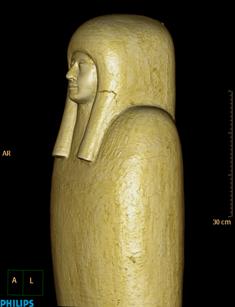 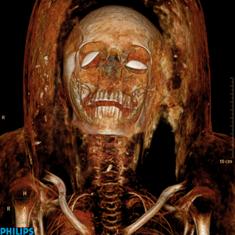 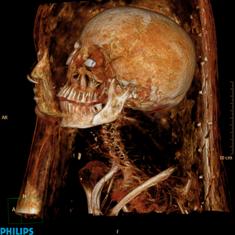 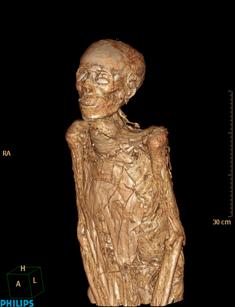 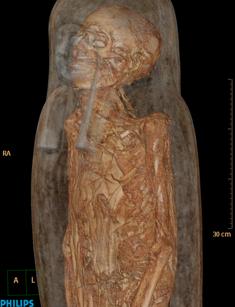 |
In this case, however, our customer was pleasantly surprised to find applications imaging a 3,000 year old mummy —something never intended by our designers who are focused on improving the lives of our patients. Nevertheless, the quality of the images shows how the Brilliance iCT offers remarkable new insights into the human body.”
The iCT works at very high speeds. In the living this means it can produce a full body scan in under a minute and accurately capture moving organs, including the entire heart in just two beats. This enables clinicians to make a speedy, accurate and comprehensive diagnosis for their patients. The first Philips iCT Brilliance scanner in the UK is expected to be installed by Summer 2009.
Details about Meresamun's health, as revealed in these CT scans form part of the exhibition “The Life of Meresamun: A Temple Singer in Ancient Egypt” at the Oriental Institute Museum at the University of Chicago from the 10th February.
See also:
CT scans and DNA tests help unveil mystery of long-lost female pharaoh (July 2007)
Results of Tutankhamen scan revealed (March 2005)
CT scans unwrap secrets of British Museum's Egyptian mummies (April 2005)
Bookmark this page